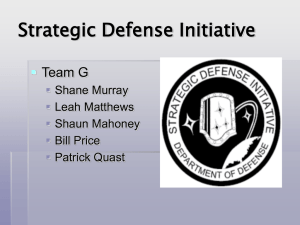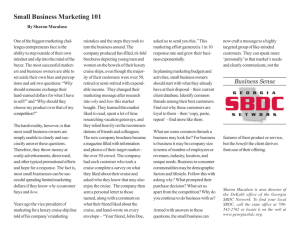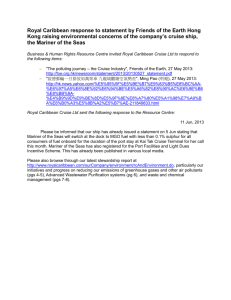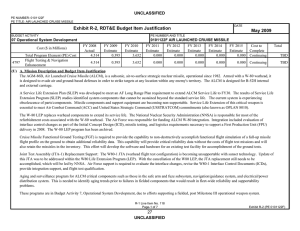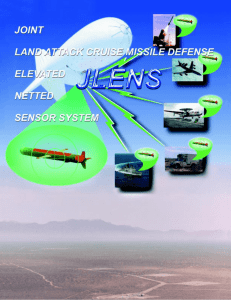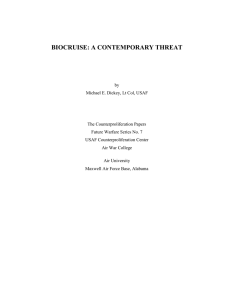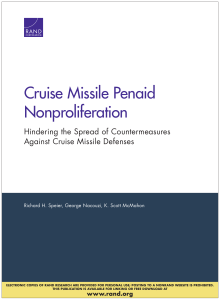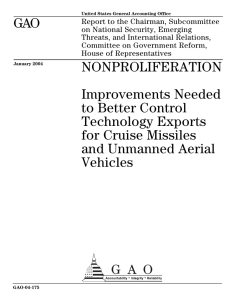Joint Cruise Missile Defense (JCMD) JOINT TEST & EVALUATION
advertisement
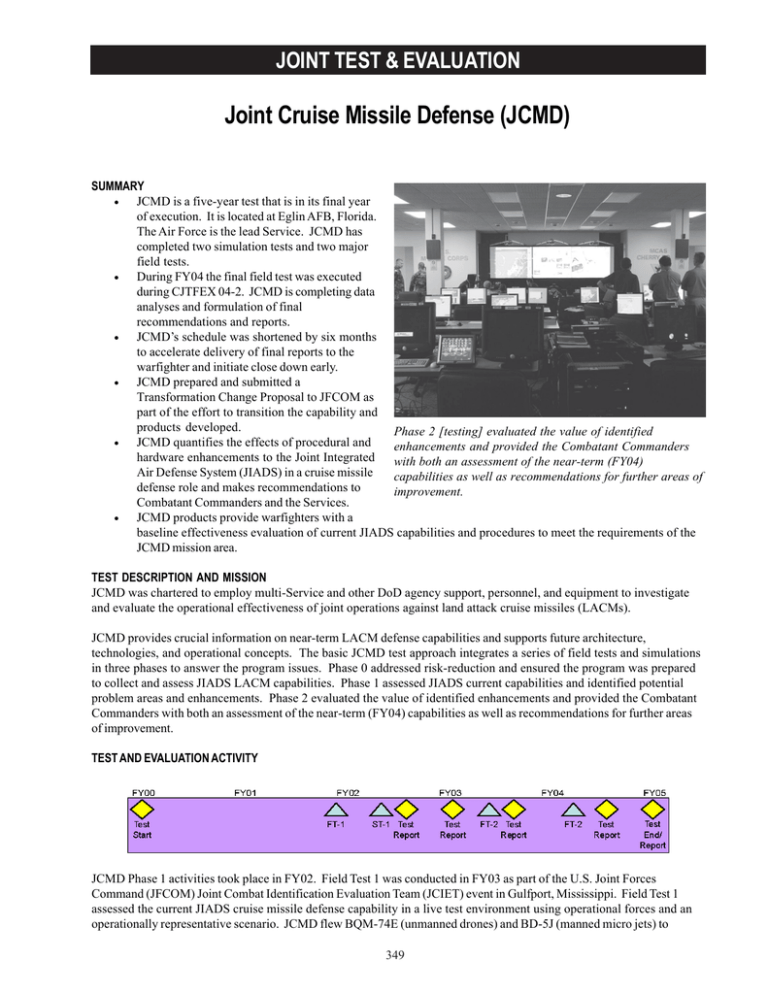
JOINT TEST & EVALUATION Joint Cruise Missile Defense (JCMD) SUMMARY • JCMD is a five-year test that is in its final year of execution. It is located at Eglin AFB, Florida. The Air Force is the lead Service. JCMD has completed two simulation tests and two major field tests. • During FY04 the final field test was executed during CJTFEX 04-2. JCMD is completing data analyses and formulation of final recommendations and reports. • JCMD’s schedule was shortened by six months to accelerate delivery of final reports to the warfighter and initiate close down early. • JCMD prepared and submitted a Transformation Change Proposal to JFCOM as part of the effort to transition the capability and products developed. Phase 2 [testing] evaluated the value of identified • JCMD quantifies the effects of procedural and enhancements and provided the Combatant Commanders hardware enhancements to the Joint Integrated with both an assessment of the near-term (FY04) Air Defense System (JIADS) in a cruise missile capabilities as well as recommendations for further areas of defense role and makes recommendations to improvement. Combatant Commanders and the Services. • JCMD products provide warfighters with a baseline effectiveness evaluation of current JIADS capabilities and procedures to meet the requirements of the JCMD mission area. TEST DESCRIPTION AND MISSION JCMD was chartered to employ multi-Service and other DoD agency support, personnel, and equipment to investigate and evaluate the operational effectiveness of joint operations against land attack cruise missiles (LACMs). JCMD provides crucial information on near-term LACM defense capabilities and supports future architecture, technologies, and operational concepts. The basic JCMD test approach integrates a series of field tests and simulations in three phases to answer the program issues. Phase 0 addressed risk-reduction and ensured the program was prepared to collect and assess JIADS LACM capabilities. Phase 1 assessed JIADS current capabilities and identified potential problem areas and enhancements. Phase 2 evaluated the value of identified enhancements and provided the Combatant Commanders with both an assessment of the near-term (FY04) capabilities as well as recommendations for further areas of improvement. TEST AND EVALUATION ACTIVITY JCMD Phase 1 activities took place in FY02. Field Test 1 was conducted in FY03 as part of the U.S. Joint Forces Command (JFCOM) Joint Combat Identification Evaluation Team (JCIET) event in Gulfport, Mississippi. Field Test 1 assessed the current JIADS cruise missile defense capability in a live test environment using operational forces and an operationally representative scenario. JCMD flew BQM-74E (unmanned drones) and BD-5J (manned micro jets) to 349 JOINT TEST & EVALUATION represent the current land attack cruise missile threat. More than 25 sorties were flown over land and sea, simulating surface and air launched land attack cruise missile profiles. JCMD’s second Phase 1 test in FY02 was a simulation evaluation of the JIADS. JCMD executed Simulation Test 1 in September 2002, at the Boeing Virtual Warfare Center (VWC), St Louis, Missouri, and the Aegis Training and Readiness Center, Dahlgren, Virginia. Operator-in-the-Loop (OITL) systems in the evaluation included the Joint Air Operations Center, Tactical Air Operations Center, Patriot, Airborne Warning and Control System, F-15C, Air Battle Management Operations Center, and Aegis Command Information Center. JCMD Phase 2 test took place in FY04 and assessed the enhanced JIADS capability. JCMD conducted Simulation Test 2 in March 2004, with the hub of operations at the Virtual Warfare Center. Simulation Test 2 integrated eight sites across four time zones via the Joint Distributed Engineering Plant bridged with the Navy Distributed Engineering Plant. These facilities include the VWC, the AWACS Integration Lab in Seattle, Washington; the Aegis Training and Readiness Center in Dahlgren, Virginia; the Distributed Mission Operations Center in Albuquerque, New Mexico; the C4I Enterprise Integration Facility (CEIF) at Hanscom AFB, MA; the E-2C System Test Evaluation Lab (ESTEL) at Patuxent River, Maryland; and the Patriot simulation at Ft. Bliss, Texas. This robust distributed OITL JIADS simulation immersed more than 100 operators in an integrated air and missile threat environment, which included fixed wing, theater ballistic missiles, ship attack cruise missiles, and land attack cruise missiles. JCMD’s Field Test 2 was conducted along the East Coast of the United States in June 2004 in conjunction with the Combined Joint Task Force Exercise 04-2 administered by Joint Forces Command (JFCOM) with 2nd Fleet being the primary executive agent. JCMD provided the Small Manned Aerial Radar Target Model-One as a cruise missile surrogate to fly against JIADS. In addition to flying 100 cruise missile sorties, JCMD demonstrated the Remote Operations Center capability by supporting the Joint Theater Air and Missile Defense daily After Action Review. TEST AND EVALUATION ASSESSMENT JCMD enhances the capability of U.S. JIADS to defeat a cruise missile attack. After evaluating baseline JIADS capabilities and procedures to meet cruise missile defense mission area requirements, JCMD quantifies the effects of procedural and hardware enhancements to JIADS in a cruise missile defense role and makes recommendations to Combatant Commanders and the Services. JCMD products provide warfighters with a baseline effectiveness evaluation of current JIADS capabilities and procedures to meet the requirements of the JCMD mission area. JCMD’s final report to be published in March 2005 will report the effects of concept of operations and TTP changes as well as command and control, sensor, and shooter system enhancements to the JIADS in a cruise missile defense role. 350

